WEBLOG:
While staying at our temporary apartment in Sacramento, California (we’re here shopping for a new home), I badly needed a pair of small desktop speakers for my laptop. After much research online, comparing reviews and assessing the specifications, I ended up with the Audioengine A2‘s.
Here’s how they look in our current temporary apartment:
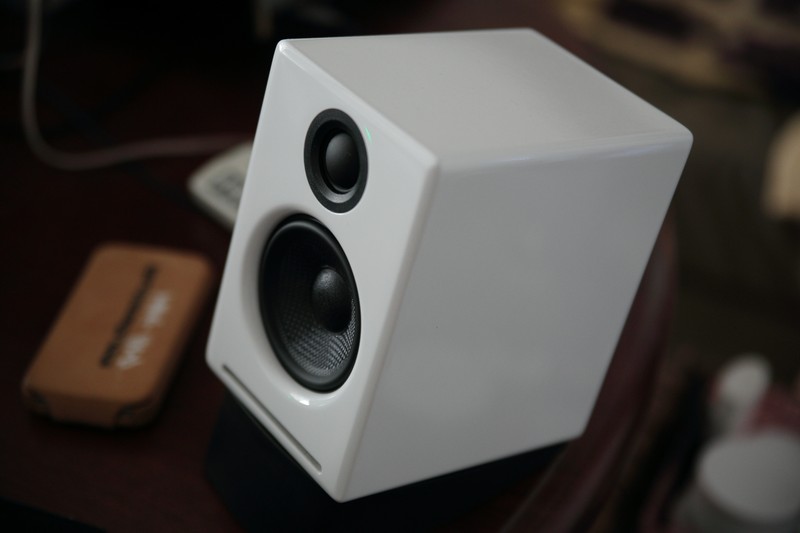
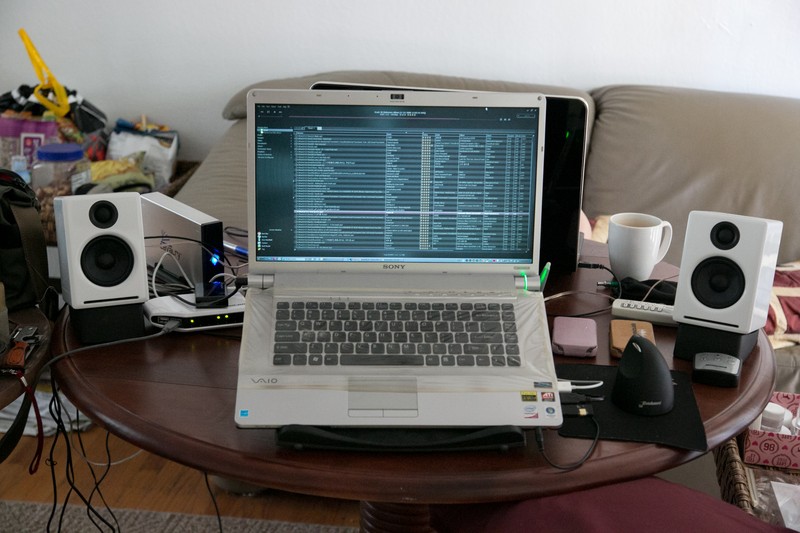
In the past, I usually travel with a very old pair of Altec Lancing ACS-90‘s I scrounged from the storage room scraps, when I contracted briefly at Broderbund/Red Orb in the late 90’s as a texture artist (working on Prince of Persia 3D). They used to be my designated traveling speakers, since the size is small enough to travel with and the build is fairly sturdy, and they actually sound quite good for their size. The sonic signature isn’t fatiguing, and there’s no annoying bass bloat like many of today’s speakers that try to impress typical consumers who don’t really care about fidelity and accuracy. Unfortunately, the power switch no longer works and I couldn’t fix it.
Because my Alec Lancing speakers are no longer working, I only took my Audio-Technica ATH-M50 headphone and my Westone 4 in-ear-monitors on this trip. Now, I’m obviously a headphone lover, but the truth is, as much as I love headphones, they will always be secondary to speakers in my life, because speakers are just that much more dimensional, natural, and convenient to listen to; there’s nothing on your noggin that could fall off, or prevent you from hearing important audio cues like phones, doorbell, neighbor screaming for help, and it’s much easier to share music with others.
After enduring only being able to use headphones for a couple of weeks, I just couldn’t stand it anymore, so I hopped online and searched for current small desktop multimedia speakers with excellent reviews. After weighing the pros and cons (size, weight, cost, portability, sound quality) and reading a bunch of professional and customer reviews, I ended up choosing the Audioengine A2.
My main reasons for choosing the A2’s were:
1) In the range of highly rated tiny speakers, they are one of the smallest, yet has the sonic signature of larger, serious speakers (audiophile/pro audio grade, as opposed to typical consumer grade). This was according to all the rave reviews out there from professional reviewers as well as consumers.
2) Stereophile has a review for the A2’s that’s practically foaming at the mouth about how incredible they are.
3) They’re the only tiny desktop speakers out there designed and manufactured in a way that’s unlike typical small multimedia speakers that use plastic and harsh sounding tweeters. The A2’s use MDF cabinet, silk dome tweeters, and Kevlar woofers, which is usually only used for larger speakers. I’ve never seen this type of design/construction used for tiny desktop speakers.
None of that makes any difference at the end of the day though. The only thing that truly matters is how they actually sound. So let me cut straight to the chase.
Yes, these are nice speakers, and for the most part they do sound very good–better than you’d think they ought to at their size, but they have two severe flaws. First, look at the frequency response graph that came with the same Stereophile review that many people like to refer to.
The bass at around 180Hz is prominently exaggerated by around 6 dB or so, and if you use a parametic EQ with modereate bandwith/Q and cut the bass at 180Hz by about -6 dB, you’ll hear what neutral/accurate is supposed to sound like. With EQ’ing it sounds much better, with more clarity and definition in the lower frequencies instead of muddied, boomy mess. Then, turn off the EQ and it’ll be painfully obvious how colored the A2’s are, after having heard the more accurate/neutral EQ’d correction.
I’m surprised by how many people out there are claiming these speakers have tight, clean bass. Can they tell the difference between neutral/accurate frequency response from colored/skewed response? Apparently, most can’t, because if you look at the reviews on Amazon, only a tiny minority of the customer reviews criticized the exaggerated bass that muddied the overall sonic signature. Even the professional reviewers who are supposed to be pro audio/audiophile experts, seem to have glossed over this severe flaw.
I don’t know why Audioengine chose to color these speakers with muddy, exaggerated bass. They actually tweaked the EQ of the DSP chip inside the speakers to get that sound, as the speaker driver/cabinet/port design is not capable of producing that kind of exaggerated bass on their own. Such a shame. These speakers could have been brilliant, but as is, they are marred by the aggressive EQ/DSP tweaking by Audioengine for what I believe, an attempt to please the typical consumers who grew up with exaggerated bass that’s so common in today’s consumer audio.
Here’s something interesting though–the A2’s actually smooth out in the bass if you aren’t listening to them in the normal listening position (with the speakers placed directly in front of you, on either side, in equilateral triangle, angled 30 degrees towards each ear). So if you are just using the A2’s to play music while walking around the room, instead of sitting between the speakers as one normally would, then the A2’s actually sound better. Maybe that’s why Audioengine colored them that way, but I doubt it, since most people listening to desktop speakers while sitting at a desk–that’s why they’re called desktop speakers. If they wanted to color the A2’s for general room listening, they could have added a bass-boost switch, so those who do listen sitting down at the desk and turn off the bass boost.
Aside from the coloration in the bass, I do like these speakers a lot. The mids and treble are very nice and smooth, though at around 900Hz and 4KHz, it could use around 3 to 5 dB of boost with moderate bandwidth/Q, in order to reach better accuracy/neutrality. But most speakers that aren’t high-end would display some kind of dip or peak in the mids or treble, and the A2’s overall frequency response in the mids and treble is good enough that I would feel fine not EQ’ing them. But because I must EQ the bass, I might as well take care of the mids and treble too.
Here’s the EQ correction I use to make the A2’s more neutral/accurate:
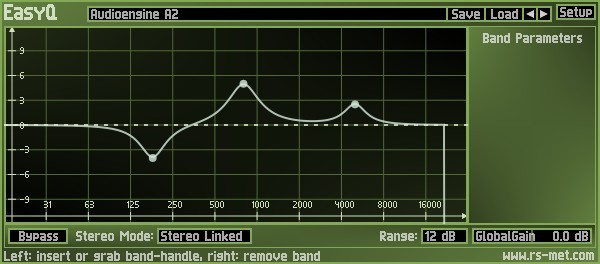
In terms of visual design, the A2’s are really nice to look at (the white version is especially striking), and they’re also constructed very well; they feel just like professional studio monitors, but shrunken down to miniature size. Anyone who’s familiar with the general quality level of small desktop speakers on the market can immediately tell that the A2’s are much higher quality than the typical plastic toys out there.
Here are a few official photos from Audioengine:
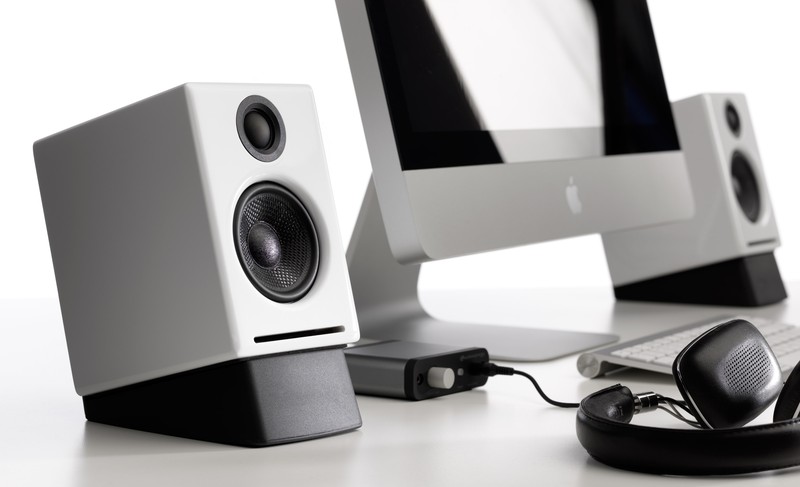
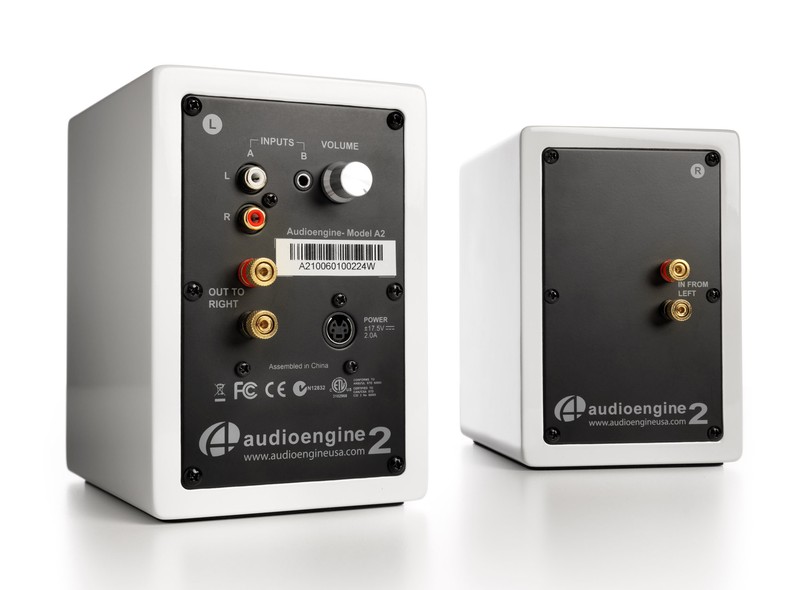
They coms in black as well:
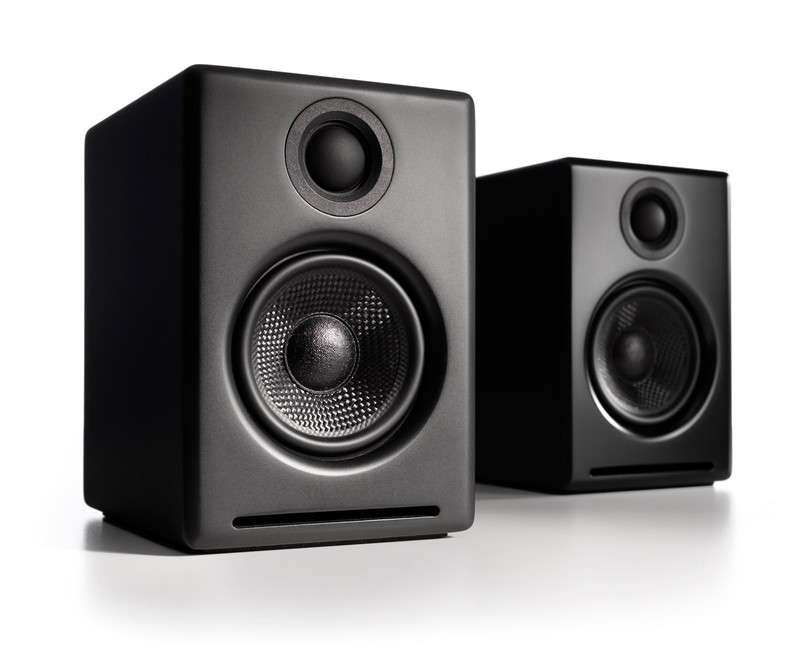
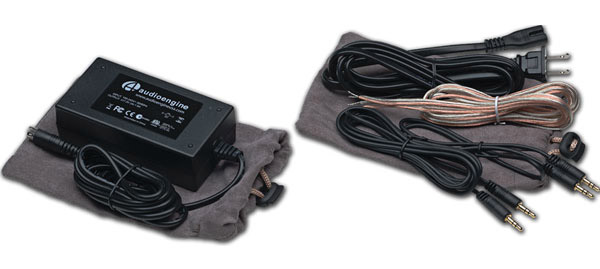
The A2’s use an AC adapter for power supply, and that’s totally fine by me. I personally never understood why some people hate the power blocks. I think they’re far better than wall-warts, and also better than adding bulk to the product’s size. Some reviewers like to point out that the A2’s use “real speaker wires,” but I’m not sure if it’s really relevant, except for maybe that you can use your own custom-length wire if you need to space the speakers very far apart (which isn’t a good idea anyway if you want to maintain any semblance of decent stereo-imaging).
The only other thing I dislike about the A2 besides the exaggerated bass, is the fact that the volume knob is placed in the back. Seriously, that’s just a really bad idea, because most people who would buy this type of tiny speakers aren’t using monitor/speaker controllers, and controlling volume with the computer software is just too dangerous; you’re one computer/software crash away from blowing out your speakers and damaging your ears permanently. Audioengine says that there’s no room for a volume knob in the front, but why can’t they think outside the box? I’d have preferred they charged a little more and provided a separate volume controller knob that’s plugged into the speaker, with about a foot long of cable (sort of like a wired remote control).
Overall, I would say that I have mixed feelings about the Audioengine A2’s. On one hand, it’s a quality product that’s rare in the world of tiny desk top speakers. On the other hand, the exaggerated bass can be a deal breaker for some (unless you EQ the speakers like I do). But once EQ’d, the A2’s do sound damn good, producing a balanced, pleasing sonic signature, and can reproduce low frequencies meaningfully down to about 60Hz without distortion. That’s no easy feat for a pair of tiny speakers. If Audioengine had voiced the A2’s without the bass exaggeration, it would have been one of the best price vs. performance ratio products I’ve ever had the pleasure of experiencing. Luckily for me, I don’t mind using EQ to refine my audio system–it’s something I do all the time anyway in my studio with all my speakers and headphones–all of them are fine-tuned for ideal neutrality/accuracy. If I’m doing that to my $7,000 reference studio monitors (using IK Multimedia’s ARC System and additional EQ), then perhaps I shouldn’t expect a $200 pair of tiny speakers to perform perfectly without any EQ.
In terms of competition, there are maybe about two or three competitors out there that can match the Audioengine A2’s in terms of sound, construction, and looks, but they tend to be either bigger in size, or too small to have any meaningful bass, or more expensive. Off the top of my head, here are a few alternatives (2.1 systems don’t count, since they include a separate subwoofer):
In terms of accessories, Audioengine sells angled speaker stands for the A2’s (it’s the black wedge under the speakers you see in some of the photos). At $29, they are expensive for a couple of rubber wedges. If you are handy with tools, you could build something similar with wood or plastic. They also sell wireless adapters/receivers, wireless DAC, and other quality products.
Audioengine makes a subwoofer (the S8) that you can get for the A2’s, and on paper, the subwoofer’s specifications look really good (only 11″ cube, with 8″ driver, and reaches down to 27Hz). I’m probably not going to get one, because the only reason I got the A2’s is for portability during traveling, and the A2’s by themselves already weigh far more compared to typical small desktop speakers (roughly 6.7 lbs. for the pair, not including the AC adapter). I might consider getting the sub to keep it in the studio though, so that I can use the Audioengine A2’s with the sub as a complete 2.1 system, acting as a third opinion (the first being the Klein+Hummel O 300D’s and the second being the Logitech Z-5500). But that seems a bit redundant, since the first two opinions already cover all of my needs (critical high-end audio, and surround sound). Maybe I can put it somewhere else in the house–I’ll have to see after we finish moving into the new home.
…
Here’s a related tip for those of you that want to EQ the audio output of Windows OS (instead of EQ’ing just the media player audio). You can google for “RTLCPL.exe,” which is part of the AC97′ driver bundle, and is compatible with most of the computers running Realtek AC97′. This is what it looks like:
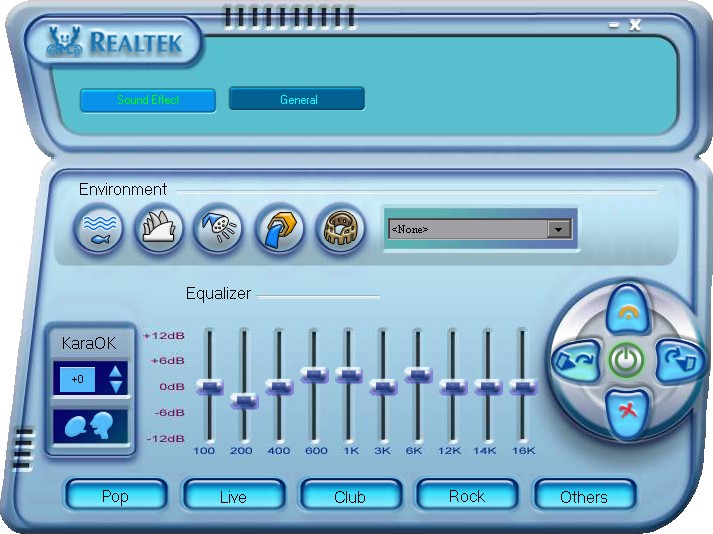
There are instructions on the web on how to make it work with your computer, and once you’re done, you can then use it to EQ the audio output of your Windows OS, which means the EQ will affect any typical situations like videos and audios streaming off the web through your web browser.
…
You probably noticed the tan-colored object next to the speaker in the first photo of the A2 review. That’s actually the new iPhone case I got recently to replace the previous one that’s fallen apart. It’s made by a company called SPIGEN SGP, and they make some really nice high-end iPhone cases. Here are a few photos:

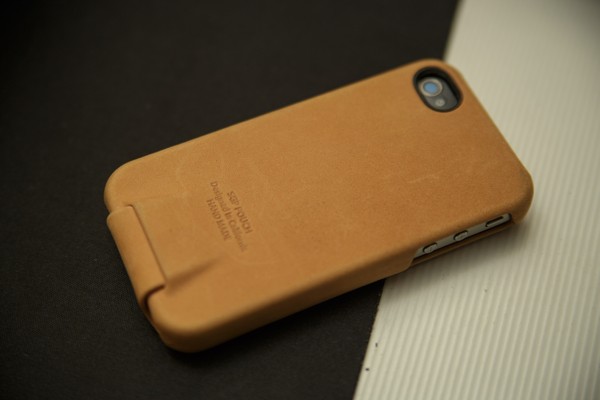
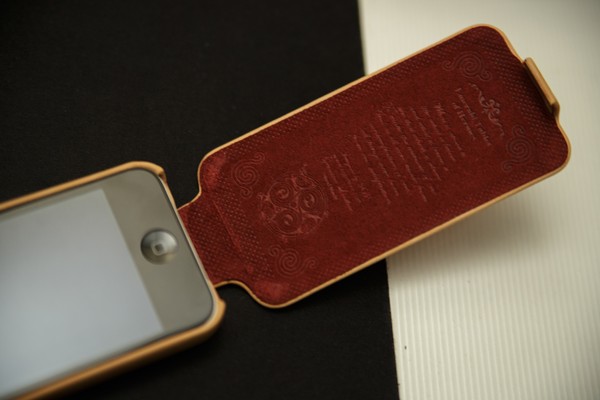
You can order it from their site here.
I like the suede leather look and feel, and it’s certainly a much higher quality product compared to the flimsy plastic case it replaced. I got the version without the “S” on the case, and it looked a bit too sparse, so I gave it a bit of contrast by writing the URL of my website and my signature in black and white–just to add some visual interest. The suede surface makes it harder to clean though, so keep that in mind.
Nice review! Can you send me EasyQ settings?
Here’s the setting:
180 Hz, -4 dB, 0.76 oct
800 Hz, 5 dB, 0.92 oct
5000 Hz, 2.5 dB, 0.63 oct
Thank you a lot! I will try. I agree with your review. Out of the box they are boomy. But otherwise for price good speakers with EQ on.
How do I EQ on a MacBook, and does this cost money? Thanks man. Clueless with this stuff.
Justin
I don’t use Mac, so I can’t help you there. Try asking at Hydrogen Audio forums–I’m sure someone there would know.
Hi. I am wondering if the new A2+ also has exaggerated bass out of the box or are they better in that area. Also, at what volume does the bass become too exaggerated? Thank you!
@Sam – As far as I can tell from the A+’s marketing, its sound is the same and only functionality has been upgraded. The exaggerated bass is there pretty much always (but take into consideration the Fletcher-Munson curve). For casual listeners, I don’t think they’d mind, since most average consumers are used to that type of exaggerated bass by now, due to so many consumers products sounding that way. For serious audiophiles, it could be a little annoying if you want perfectly balanced sonic signature. For me, I use it for casual listening in my exercise room when working out, and for that type of purpose, it’s totally fine. If I were to put it on a desk for more critical listening, I’d EQ it to be more neutral.
I bought a set of A2+ a month ago and my thoughts are similar to Rob’s about the A2. When new, the A2+ were bass heavy and the treble recessed. I contacted Audioengine about it and they suggested the speakers needed about 40-50 hours of break-in. Well, they were right. After about 40 hours, the bass tightened up and the treble is less recessed than it was. I also aimed the speakers straight ahead, instead of the usual toe-in, and, counter-intuitively, the change helped. My guess is that these were voiced to be inoffensive at background levels when located next to your computer at arm’s length. All of that said, I’m looking for a speaker cable that will tilt the balance a bit, maybe entry-level AQ. Any thoughts?
I would steer you away from any kind of special/expensive cables that are meant to alter/improve the sound. There have been a lot of scientific double-blind tests done on audio cables and every single one of them proved that really expensive cables were no better than the most common/cheap cables. Whatever minor differences there might be, is so minute that it’ll be dumb to pay money for that kind of diminishing returns.
Instead, what I recommend is to simply use a quality EQ. Either use a software parametric EQ plugin (lots of quality freeware out there. I use EasyQ, which is excellent). You can use media players/managers that hosts plugins, such as J River Media Center, Media Monkey, Winamp, etc (I use Media Center). If you don’t want to use a software plugin, you can use a hardware EQ unit. Just search any of the pro audio retail websites (sweetwater, guitarcenter, musiciansfriend, zzounds, etc) and you’ll find lots of choices. If you want to hijack the audio output at the operating system level so all audio is affected, then take a look here: http://www.head-fi.org/t/660032/finally-a-signal-processing-app-includes-eq-for-your-oss-audio-output-windows-and-mac
Thanks!
The A2+ is extremely colored and has a huge bump at 162Hz which is a shame because it makes integration with a sub difficult.
I used a bit of a trick to further improve A2+ sound if you are using a sub. The results are very good and bring the a2+ up to another level.
I basically set the sub to maximum bandwidth and volume and then EQ the a2+ down below 160Hz. This way the A2+ midrange opens up a bit. The idea is to minimize audio signal energy below 160Hz but compensate for this with the sub volume setting.
Here are my EQ settings:
Parametric EQ settings:
-13dB 162Hz Q=3 (nasty A2+ bump)
+4.5dB 4Khz Q=1
-11dB 3Khz Q=1.33
+2.5dB 1073Hz Q=1.45
-1.5dB 1590Hz Q=2
-1.2dB 4763Hz Q=6
-2.5dB 7686Hz Q=2
-17dB 160Hz low shelf (the sub volume compensates for this)
I also boost above 10Khz but that’s my personal taste to get extra sparkle.
Cheers
I’ve been a long time A2 listener (not A2+) the A2 has the same exaggerated base sound so I don’t think they are doing any special DSP tricks to achieve the sound. That is simply the way the speaker is tuned with the cabinet, crossovers and drivers. I have always used them connected to my Airport Express for Airplay.
Recently I decided to buy a subwoofer to integrate with them, after moving to place that had more space for a subwoofer. Long story short, integrating these things with a subwoofer is nearly impossible to make it sound right on their own.
I think I found a solution that I am going to try out though. I just ordered the miniDSP 2.4 HD. Which will serve as my DAC (hopefully an upgrade over the one in the APExpress), DSP Equalizer, and subwoofer XOver integrator. I should be able to tune everything very flat with with the subwoofer.
Here is a link explaining the process if anyone is interested.
https://www.minidsp.com/applications/digital-crossovers/subwoofer-integration-with-minidsp
@Dan – Adding a subwoofer can be a real headache to integrate and make the whole system sound coherent. I just went through that myself not long ago when I added the Neumann KH 805 to my Klein+Hummel O 300Ds. I had to do the “subwoofer crawl” and write down the frequency response at every frequency interval on a piece of paper, at multiple possible positions I could place the subwoofer, then make a chart that compared the results. The position that gave me the flattest average response and least individual severe nulls and peaks was chosen. Then I adjust the EQ/volume of the sub itself with the controls on the back of the sub, getting it as close to neutral as possible. The rest is just using IK Multimedia ARC System 2 for the final room/speaker correction. It was a lot of work, but now I have an amazing sounding 2.1 system that’s pretty much perfectly flat from 20 Hz to 20 KHz at my listening position, and man, it sure is sonic bliss.